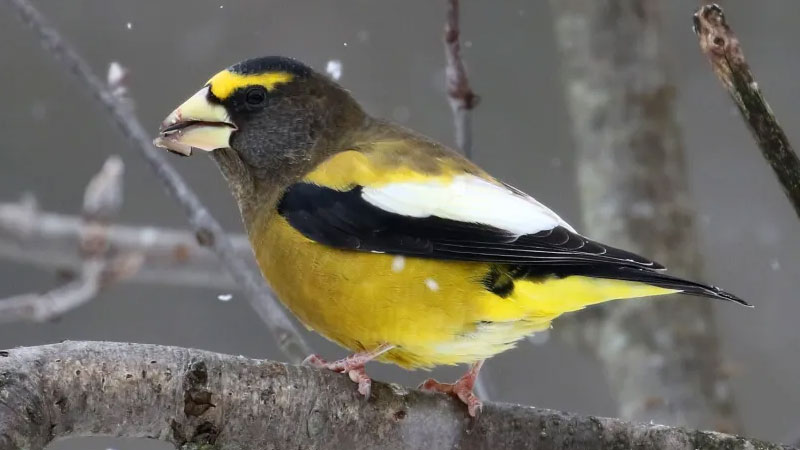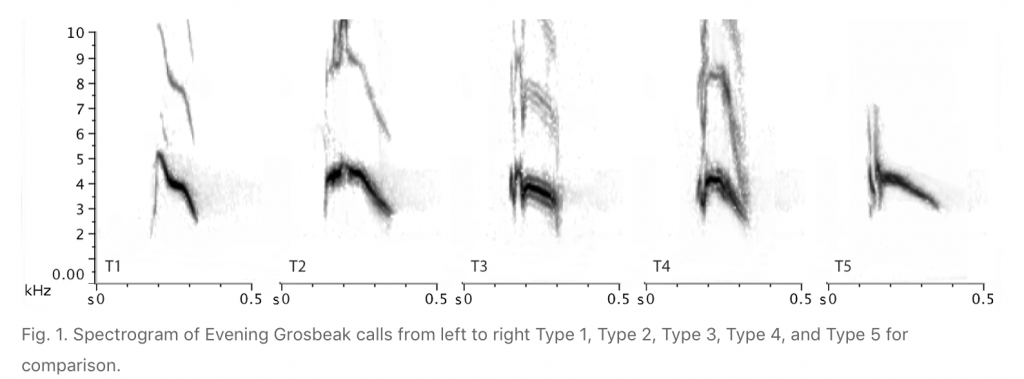Evening Grosbeak
Coccothraustes vespertinus Cooper (1825)
Photo: © Jay McGowan

Appearance: Large finch with robust proportions. Massive conical bill pale greenish yellow (color more intense in spring). Males overall yellow, females more brown to olive in color.
Size: L 8″
Shape: Medium-sized, short-legged, large-headed bird with a very deep-based conical bill and relatively short, notched tail. Line of culmen fairly continuous with flattened forehead and shallow.
Both Sexes: Bill pale greenish in spring and summer, paler cream/yellow in winter. Adult Male: Bright yellow eyebrow and forehead, contrasting with the rest of dark head; underparts (including undertail coverts) deep yellow; wings and tail black except for white tertials, inner secondaries, and inner greater coverts.
Adult Female: Grayish head and back separated by dull yellowish collar; pale gray to buffy-gray chest and belly; white undertail coverts; blackish wings with grayish tertials, inner secondaries, and inner greater coverts; white patch at base of prima- ries conspicuous in flight.
Juv: (June–Oct.) Like adult female but browner overall and with a yellow wash to inner greater coverts; as in adult, juvenile female has white patch at base of prima- ries; male has none.
Irruptions:
Taxonomy: – Evening Grosbeak (Type 1) Coccothraustes vespertinus brooksi (Grinnell, 1917)
Evening Grosbeak (Type 2) Coccothraustes vespertinus californicus (Grinnell, 1917)
Evening Grosbeak (Type 3) Coccothraustes vespertinus vespertinus (Cooper, W, 1825)
Evening Grosbeak (Type 4) Coccothraustes vespertinus warreni (Grinnell, 1917)
Type 5 Evening Grosbeak Coccothraustes vespertinus montanus (Ridgway, 1874)
Object of study: assortative mating, morphometrics, flight call variations and genetics for all call types, but especially with Type 1 which overlaps with all the other call types to some degree.
Submit your sightings to eBird (including type and audio) to help answer some nagging questions:
- To what extent will Type 1’s irrupt from year to year? Distance? Quantity?
- Are the types geographically isolated during the breeding season?
- Do they overlap in parts of their range but only breed with the same type?
- What other, more complex things may be happening on the breeding and wintering grounds?
- Do Types form mixed flocks during the winter

Evening Grosbeak (Type 1) Coccothraustes vespertinus brooksi (Grinnell, 1917)
Natural History: Commonly breeds across the Pacific-Northwest, its core range. Type 1 is the most widespread type in the west, from the northern Rockies and the Cascades to at least British Columbia and south to Oregon, northern Wyoming, and the Black Hills of South Dakota. Wanders to the northern Sierra Nevada and to San Bernardino California, and to Colorado, Arizona and New Mexico. Recordings by Aaron Bowman recently confirmed Type 1 in north coastal Alaska. Known to occasionally overlap in range with Types 2, 3, and 4, including during the breeding season. Might also overlap in range with Type 5 in Arizona. Type 1 occurs across most of the west, but more recordings are needed to accurately reflect its actual range and how often it irrupts and overlaps with the other call types. Flight call sounds like a descending chee-er; said to have a more pure-tone that begins at a high frequency, rises slightly, and then descends rapidly (Sewall et al. 2004). Its call is more thin and whistled. The other call types described as tee-er, keeer, peeer, p-teeee, p-teer and clee-ip, among other variations.
For more on Type 1 Evening Grosbeak see here:
https://ebird.org/news/evening-grosbeak-call-types-of-north-america
Evening Grosbeak (Type 2) Coccothraustes vespertinus californicus (Grinnell, 1917)
Natural History: Core breeding range is largely restricted to the Sierra Nevada of California where it commonly breeds; occasional to Oregon in s. Cascades and rarely to Washington and amazingly a record in North Dakota. eBird map
Flight call: tee-er; thinner in quality and tends to sound higher pitched (Sewall et al. 2004). Begins with a pronounced rise followed by a gradual and steady drop in frequency. Type 2 is similar to Type 1, but is a bit more explosive, whistled, and piercing. Type 2 flight calls are high and clear-sounding. Spectrographically Type 2 is similar to Type 1 with a distinctive inverted “V” shape. calls, but without modulation or banding evident in spectrogram.
For more on Type 2 Evening Grosbeak see here:
https://ebird.org/news/evening-grosbeak-call-types-of-north-america
Evening Grosbeak (Type 3) Coccothraustes vespertinus vespertinus (Cooper, W, 1825)
Natural History: Core breeding range is boreal forests of Canada east of the Rockies to Newfoundland and in the northeastern United States; wanders southward to the southern Appalachians and historically rarely to the Gulf Coast, but such events have become much less common the last 25 years. Flight calls a clee-ip; begins with a harsh trill and then only slightly descends. Burry and resembles call of House Sparrow. Type 3 flight calls look most like Type 5, but overall are quite distinctive spectrographically.
For more on Type 3 Evening Grosbeak see here:
https://ebird.org/news/evening-grosbeak-call-types-of-north-america
Evening Grosbeak (Type 4) Coccothraustes vespertinus warreni (Grinnell, 1917)
Natural History: Breeds in a core area from central to southern Rockies of Utah, Colorado and New Mexico; occasionally wanders and likely breeds north to the vicinity of Jackson Hole, Wyoming and rarely to central Montana. Flight call a “p-teer;” a very rapid frequency drop followed by an abrupt rise. Similar to Type 2, but huskier or burrier sounding.
For more on Type 4 Evening Grosbeak see here:
https://ebird.org/news/evening-grosbeak-call-types-of-north-america
Type 5 Evening Grosbeak Coccothraustes vespertinus montanus (Ridgway, 1874)
Natural History core range appears to be the Sierra Madre of Mexico, north to southeastern Arizona and the bootstrap of sw. New Mexico. All knowledge of this Call Type is based on two recordings by R. Hoyer from the Huachuca Mountains. Theflight call a long-sounding “cheeeerr” Type 5 flight calls are quite ringing, burry, and piercing, with a strong descending sound evident in the field.
For more on Type 5 Evening Grosbeak see here:
https://ebird.org/news/evening-grosbeak-call-types-of-north-america
Irruptions: – Type 3 is most irruptive of all the types. Wanders south in the mountains in the East, but irruptions have been much smaller and infrequent south of Pennsylvania in the last 15+ years. Prior to the 1980s wandered as far south as Georgia with some regularity, but in recent decades it is very rare south of the Northeastern states. From 1967-1991, Evening Grosbeaks showed up every year during the Ithaca, NY Christmas Bird Count. Type 3 should irrupt in northeastern states and down the Appalachians to the Carolinas.
Type 1 is the most irruptive and widespread type in the West, and quite likely the most abundant too, often irrupting to foothills areas throughout much of the West.
Other types are thought to be far less irruptive.



